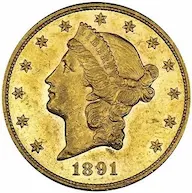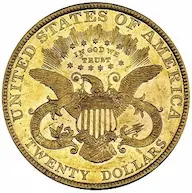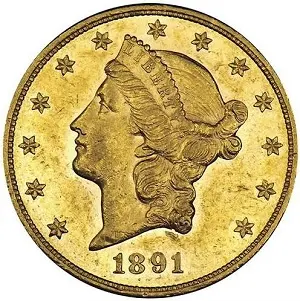1891 Coronet $20 Double Eagle
When the year 1888 drew to a close, some 315 million Morgan silver dollars had been struck under the mandates of the Bland-Allison Act of 1878. The intent of the Act was to lift the price of silver, but with so much of the whitish metal on hand, prices continued to fall.(1)
In 1889 and 1890, six states were admitted to the Union – North Dakota, South Dakota, Montana, Washington, Idaho, and Wyoming. These states greatly increased the political clout of farming and mining interests in Congress.(2)
With the necessary reinforcements, Bland-Allison was replaced by the Sherman Silver Purchase Act on July 14, 1890. The main thrust of the Sherman Act was to require the federal government to purchase even more silver than before. The government paid for the silver with Treasury notes that could be redeemed in either silver or gold.
Going into 1891, Morgan dollar output at the Philadelphia Mint remained high. With so many resources dedicated to the production of silver dollar coinage as compelled by law, the gold double eagle was almost forgotten: only a scant 1,390 circulation pieces of the $20 denomination were struck at Philadelphia in 1891.(3)
The lack of gold bullion also hindered double eagle production in 1891 at Philadelphia,(4) but the imbalance between gold and silver availability had an impact far beyond Mint operations. With the continued flood of silver, its value had fallen to the point where the silver content in a dollar coin was worth only 60 cents.(5)
As more Americans grew uneasy about this situation, gold increasingly became the preference for redemption of the Treasury notes issued to purchase the Sherman Act silver. European nations demanded gold as well, out of concern the United States would otherwise pay its debts in silver coins worth about half their face value after melting.(6)
Within a couple of years, the constant drain of Treasury gold reserves set off a widespread economic calamity known as The Panic of 1893.
The discovery of an immense gold deposit at Cripple Creek, Colorado eventually eased the shortage of bullion.(7) Repeal of the Sherman Act ended high volume production of the Morgan dollar and freed up coinage manufacturing capacity.(8) These factors contributed to a rise in gold coin output. By 1893, double eagle production at the Philadelphia Mint rose to 344,280, ballooning to 1.37 million in 1894.(9)
With these historical underpinnings surrounding the 1891 Coronet double eagle, it’s easily understood why this is such an elusive coin in all grades today, with an estimated 104 examples extant.(10)
Prices have exploded since the mid-2000’s, but this is merely a repeat pattern going back many decades. Although the 1891 double eagle has earned top level respect in numismatic circles, some experts insist it remains an underrated issue.(11)
| Estimated survivors in all grades: 104 ?
The survivor estimate from PCGS represents an average of one or more experts' opinions as to how many examples survive of a particular coin in all grades. Survival estimates include coins that are raw, certified by PCGS, and certified by other grading services. Learn more at PCGS. |
| PCGS Rarity Scale: 7.9 ?
The 'PCGS CoinFacts Rarity Scale' assesses the relative rarity of all U.S. coins, based on estimated surviving examples. The scale runs from 1.0 to 10.0. The higher the number, the rarer the coin.
Learn more at PCGS. |
| Search for the 1891 Coronet $20 Double Eagle on eBay** |
Preview of eBay selection (a very tough date... also try Search link above):
 |
 |
| Trendline Avg = 21.39 | BETTER |
 |
 |
| Trendline Avg = 21.39 | BETTER |
Historic Value Trend Charts:
| Last updated 10-14-25 | Return to Key Date Coin List | |
| Compare to Common Date Coin of Same Type | ||
|
|
||
| Download Charts to Your Computer | ||
Sources
1. Yeoman, R.S. and Garrett, Jeff, et al. A Guide Book of United States Coins, 75th ed. Pelham, AL: Whitman Publishing, 2021.
2. Todd, Lewis P. and Curti, Merle. Rise of the American Nation, 3rd ed. New York, NY: Harcourt Brace Jovanovich, Inc., 1972.
3. Heritage Auctions. 1891 $20. Jan 2014 Auction.
4. Heritage Auctions. 1891 $20. Aug 2014 Auction.
5. Todd, Lewis P. and Curti, Merle. Rise of the American Nation, 3rd ed.
6. Taxay, Don. The U.S. Mint and Coinage. New York, NY: Sanford J. Durst Numismatic Publications, 1966.
7. Stack's Bowers Galleries. 1894 Liberty Double Eagle. Aug 2014 Auction.
8. Taxay, Don. The U.S. Mint and Coinage.
9. Yeoman, R.S. and Garrett, Jeff, et al. A Guide Book of United States Coins, 75th ed.
10. PCGS. 1891 $20 (Regular Strike).
11. Heritage Auctions. 1891 $20. Apr 2021 Auction
**Many very fine coin dealers sell on eBay. At any point in time, there may be over one million search results for United States coins. This includes quite a few of the recommendations on our Key Date Coin List.
If you’re thinking about purchasing a rare coin, eBay is certainly worth a look. For your convenience, the links from this site to eBay are coded to bring up only coins certified by PCGS and NGC.
As is always, always the case, never buy a valuable coin from a seller whose trustworthiness cannot be verified. Learn more about this at our chapter Best Places to Buy Coins, which also has a section on doing business on eBay.
In the interest of full disclosure, Rare Coins 101 receives a small commission anytime someone connects to eBay from this site and purchases something.
Coin images by Stack's Bowers Galleries.


